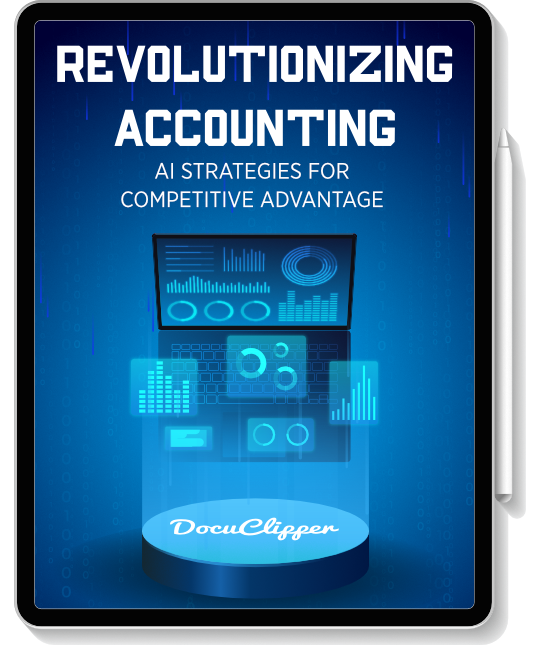Getting data from a series of various documents takes time and effort. It needs efficiency to get info without mistakes and losing time.
Documents can vary from financial statements, reports, ledgers, and legal documents. It takes a trained eye and a sophisticated software system to do this.
In this blog, we’ll talk about how to automate document data extraction processes and how to do them efficiently.
What is Document Data Extraction?
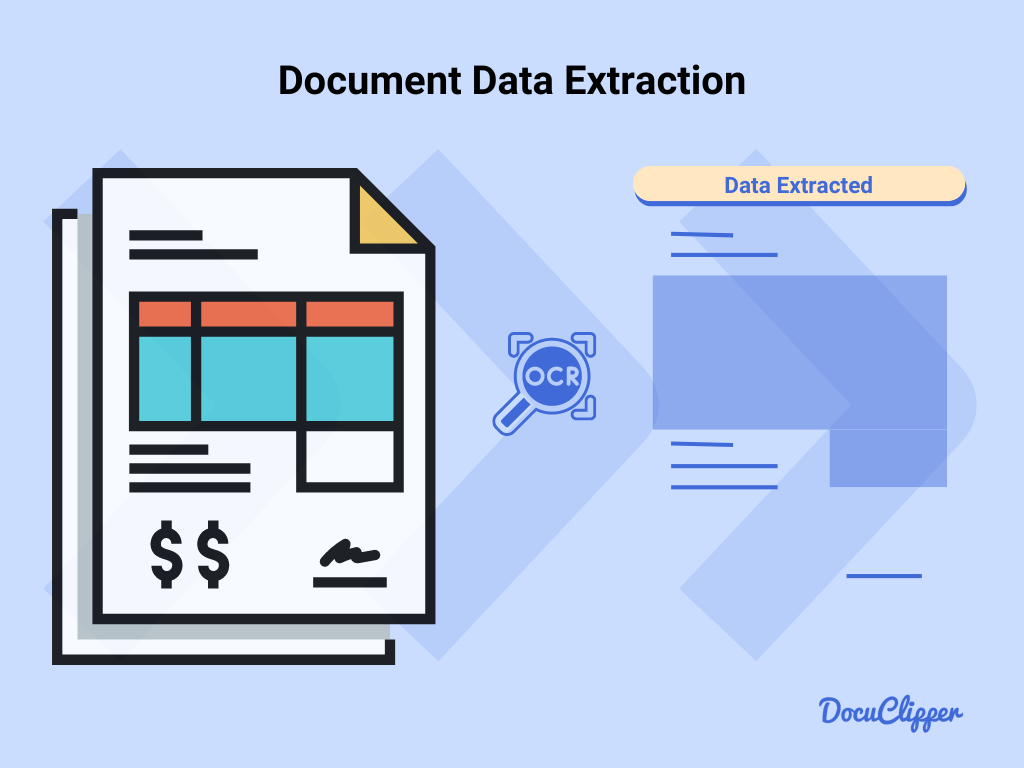
Document data extraction is the process of extracting desired information from a document.
Document data extraction is necessary for industries like finance, health care, insurance, and legal services.
This process involves gathering important information from various documents, such as forms, financial reports, and research papers.
It helps organizations make better decisions by enabling them to analyze trends and assess risks accurately. Effective data extraction requires precise tools to ensure the data is handled reliably.
How Does Document Data Extraction Work?
Document data extraction is all about pulling important information from documents and centralizing the data in your software or spreadsheet..
While some people still do this manually, which takes a lot of time, many now use automation software such as OCR because it handles large amounts of data quickly and with fewer errors.
This switch to automation saves time and improves accuracy, allowing businesses to focus more on analyzing data and making decisions. This process boosts efficiency and helps companies work smarter.
Use Cases of Document Data Extraction
It sounds generic since extracting data sounds simple from a document, but here are some examples of where they are used in the real world:
Financial Documents
Extracting data from financial documents such as bank statements, invoices, or receipts helps in checking account balances, organizing transactions, and analyzing finances.
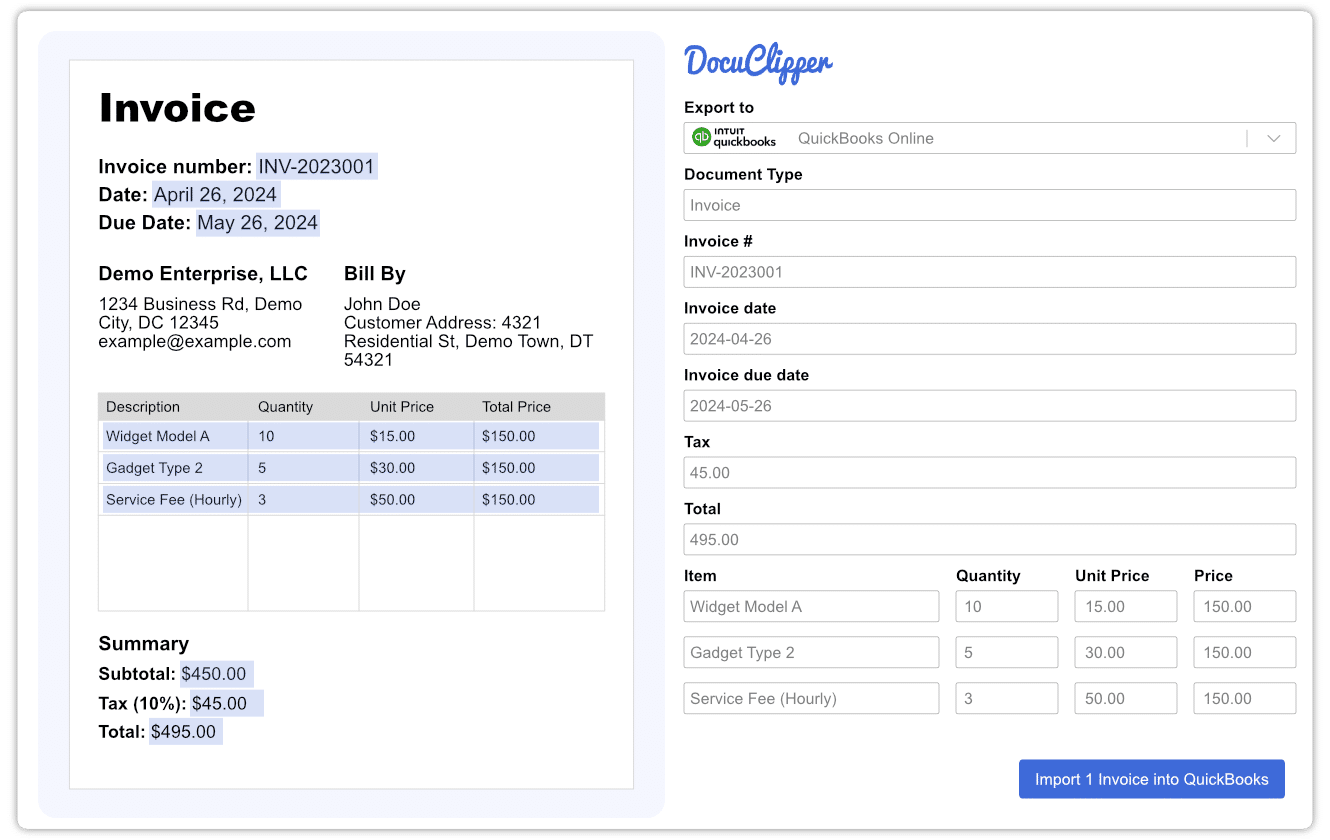
Most accountants extract data using OCR, which stands for Optical Character Recognition, to quickly pull information from bank statements and other financial papers. This tool reduces mistakes and saves time, making financial tasks easier to manage.
For example, DocuClipper helps finance professionals to convert bank statements, extract data from invoices, and capture data from receipts.
Legal Documents
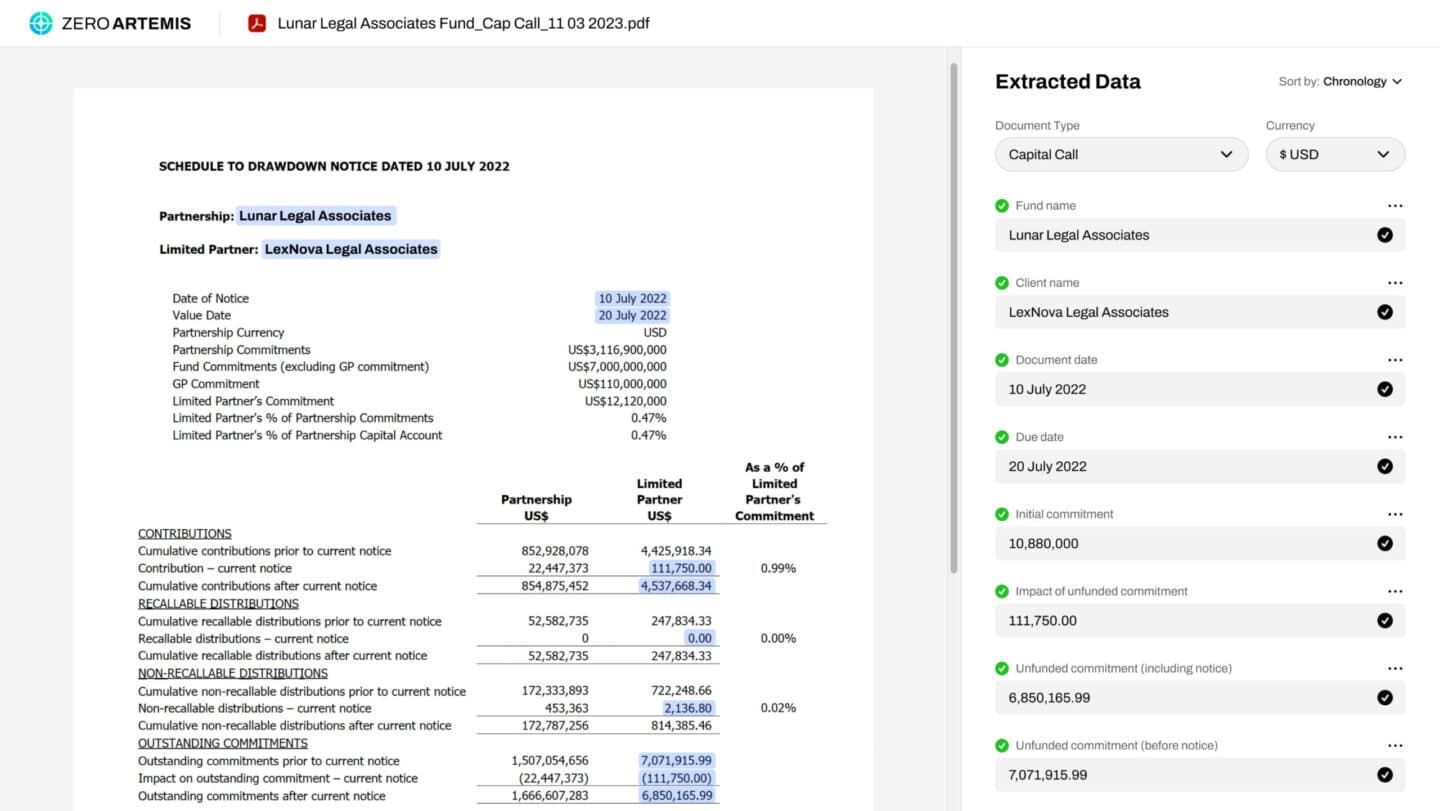
Extracting data from legal documents is often used to quickly find specific sections in contracts, such as those dealing with freelance work, partnerships, and employment. It’s also useful for checking criminal records and offenses.
By automating this process, businesses and legal teams can easily get to important information in contracts and ensure they meet legal requirements. This saves time and lets them focus on more important tasks.
Healthcare Records
Extracting data from healthcare means pulling out key health information from medical records to help doctors diagnose and treat patients. It lets doctors quickly see a patient’s health details, like body functions and medications, which helps them make better care decisions.
This process not only speeds up the review of medical histories but also ensures treatments are based on accurate and up-to-date information, leading to better health results for patients.
Insurance Documents
Extracting data from insurance documents helps users understand their insurance coverage. It checks if they are eligible for benefits and how much they can receive.
This process makes it easier for individuals to know what their insurance covers and to prepare for any claims they might need to file. With clear information, users can make better decisions about their healthcare needs.
Methods of Document Data Extraction
There are many ways of extracting data from different sources. You can do it manually or by using computer software that makes it a lot easier
Manual Document Data Extraction
Manual data extraction involves individuals entering data from physical or digital documents into databases, spreadsheets, or other systems by hand. It typically requires reading through documents, identifying relevant information, and typing it out or copying and pasting it into the desired format.
This method allows for a detailed examination of documents, providing a deep understanding of the content. It can be particularly useful where precision and a nuanced understanding of complex documents are critical.
However, manual extraction is slow and often prone to errors. Human input can lead to inconsistencies, reducing overall efficiency. Accounting professionals claim that 27.5% of their data were extracted incorrectly when doing it manually.
This process is labor-intensive and can significantly delay data processing, impacting decision-making and productivity in a business setting.
As such, many organizations are shifting towards automated solutions to overcome these challenges and improve accuracy and speed.
Automated Document Data Extraction
Automated data extraction uses software to automatically pull information from documents and input it into relevant systems. This technology relies on algorithms that can identify specific pieces of data across a variety of document formats.
These methods are fast, accurate, and highly scalable. They can process large volumes of documents quickly, reducing the time required to handle data entry tasks.
34% of small to medium-sized businesses claim that automation reduced their errors when processing documents.
This efficiency improves overall productivity and allows businesses to handle growth without the need for proportionally increasing their manual labor force.
Furthermore, the precision of automated systems often surpasses human capabilities, minimizing the occurrence of errors.
The main limitation of automated extraction is its dependency on algorithms, which might not interpret every document correctly, especially if the document’s format deviates from the norm or contains unfamiliar elements.
There are also limitations with the OCR used in automated document data extraction like image quality, alignment, orientation, and font.
Automated Document Data Extraction Process
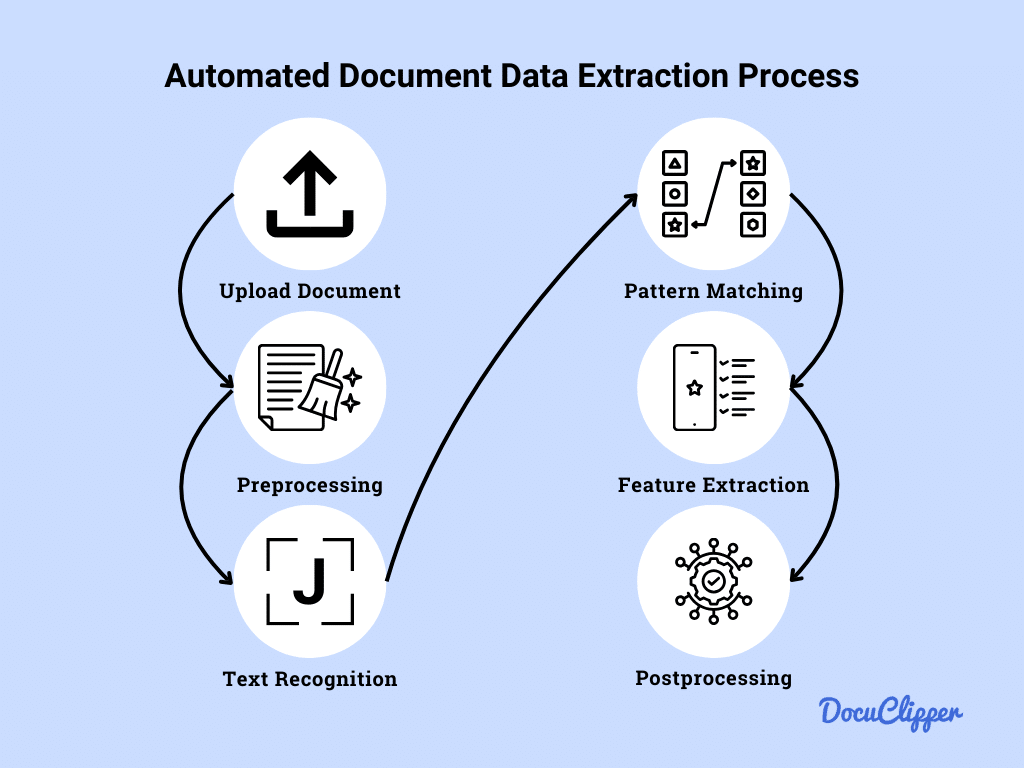
Automated document data extraction often employs OCR to scan and convert documents into machine-readable text.
Here’s how the OCR data capture process works:
- Upload Image/Document: Users upload an image or document containing text. The clarity and quality of the image significantly impact the accuracy of the OCR process.
- Preprocessing: The OCR system begins by enhancing the image quality. It cleans up any noise and optimizes the document for text extraction. This includes adjusting lighting and standardizing font sizes, which are crucial for improving the accuracy of character recognition.
- Text Recognition: OCR uses two main steps to recognize characters:
- Pattern Matching: The software compares the characters in the image to known character patterns stored in its database to identify each character.
- Feature Extraction: This step involves algorithms analyzing unique features of each character, such as line thickness and curvature, to distinguish them accurately.
- Postprocessing: Once characters are recognized, the OCR system undertakes error correction and context analysis. This final step assembles the recognized characters into coherent and accurate text, ready for use in various applications.
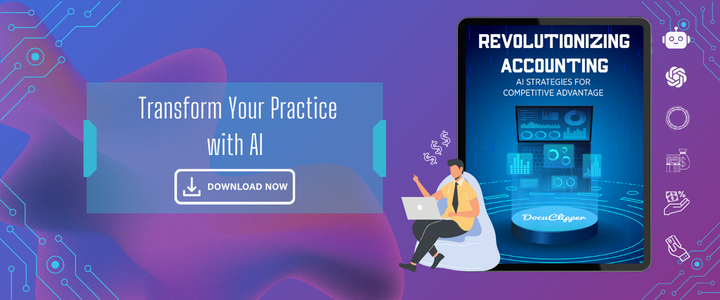
Best Practices to Improve Accuracy of Automated Data Extraction Process
To improve the accuracy of automated data extraction processes, follow these straightforward best practices:
- High-Quality Scans: Start with clear, well-lit images of documents. Good-quality scans reduce errors during data extraction and improve OCR accuracy.
- Adjust Document Settings: Use preprocessing techniques like adjusting contrast and removing background noise to make texts easier for OCR systems to read.
- Customize Settings: Customize OCR settings to match the specific types of documents you are processing, optimizing for the best results.
- Human Review: Include a step where people check and correct the OCR results. This combination of human oversight and technology ensures higher accuracy.
- Regular Updates: Keep your OCR software updated to benefit from the latest advancements and improvements in technology.
- Use Context: Apply algorithms that consider the context around the text, helping to correctly interpret ambiguous information.
Conclusion
Automated data extraction transforms how businesses handle documents, from financial statements to legal contracts. By shifting from manual methods to automated systems like OCR, companies can process data faster, more accurately, and at scale, enhancing decision-making and operational efficiency.
Incorporating OCR tech which supports diverse document types and integrates with major accounting software, further streamlines this process, making it an essential tool for modern business environments.
How DocuClipper Can Help with Financial Document Data Extraction
DocuClipper is a tool designed to streamline financial document management, supporting a variety of documents such as bank statements, credit card statements, invoices, and more.
It offers a high accuracy rate of 99.5% with its specialized OCR algorithm, ensuring reliable data extraction and minimizing errors from PDF to Excel, CSV, and QBO.
The system is efficient, converting documents in about 20 seconds and automating batch processing and transaction categorization.
Additionally, DocuClipper integrates seamlessly with accounting platforms like Xero, Sage, and QuickBooks through its API, enhancing financial workflows by allowing real-time data updates and comprehensive financial management.
This integration supports automatic reconciliation and advanced analysis, facilitating informed decision-making and saving administrative time.
FAQs about Automated Data Extraction
Here are some frequently asked questions about extracting data from documents by automated means:
What is automated data extraction?
Automated data extraction uses software to automatically pull important information from documents into databases or spreadsheets.
How does automated data extraction improve efficiency?
It processes large volumes of documents quickly, reducing the time spent on manual data entry and allowing for real-time data analysis.
Can automated extraction work with any document type?
Yes, modern systems are designed to handle various document types, but effectiveness can depend on the document’s format and quality.
What are the main benefits of using DocuClipper for data extraction?
DocuClipper offers high accuracy, integrates with accounting software like QuickBooks, and speeds up the extraction process, among other benefits.
How does OCR technology work in data extraction?
OCR, or Optical Character Recognition, scans text from images and converts it into editable and searchable data.
Is automated data extraction expensive?
Costs vary, but tools like DocuClipper provide scalable solutions that can be cost-effective for businesses of all sizes.




